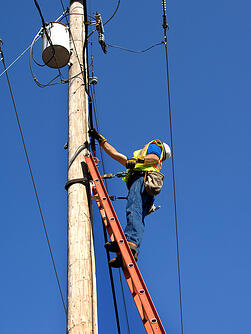Ensuring Public Safety with Utility Pole Inspections
 The standard utility pole in the United States is 40ft long (though it can reach up to 120ft) and can carry voltages of up to 33 kilovolts. Between its physical and electrical capacity, a utility pole has the potential to cause a lot of damage, and to do a lot of harm, if it is not properly maintained. Protecting the public should be a primary concern for any pole owner, and utility pole inspections are crucial in this matter.
The standard utility pole in the United States is 40ft long (though it can reach up to 120ft) and can carry voltages of up to 33 kilovolts. Between its physical and electrical capacity, a utility pole has the potential to cause a lot of damage, and to do a lot of harm, if it is not properly maintained. Protecting the public should be a primary concern for any pole owner, and utility pole inspections are crucial in this matter.
Utility pole inspections are used to:
-
Find wood decay, rot, hollow areas and cracks.
-
Test poles for strength.
-
Identify all company and foreign-owned attachments.
-
Evaluate soil and climate conditions.
-
Identify any potential environmental dangers.
This information can help pole owners determine if utility poles need to be treated for rot and decay or reinforced with metal braces, for example (helping extend the life of the utility pole), or are in danger of falling and need to be replaced. It can also help determine if a pole is at capacity before allowing another attacher to join (potentially overloading it and causing it to fall), and catch illegal attachers (another source of potential overloading that could cause poles to fall.)
Once utility pole inspections are performed, the data gained from them should be organized and maintained as it can help in additional safety measures. For example, in addition to ensuring public safety, the data gained from utility pole inspections can also help ensure the safety of utility workers. If notes from pole inspections are recorded in a database system, they can cite work site hazards, such as nearby environmental details or energized overhead lines that linemen need to be made aware of. Weak or damaged poles that have not been properly inspected and reinforced or replaced can present a serious danger to workers who are climbing the poles for regular maintenance activities as well. Their extra weight can cause these poles to fall, possibly resulting in injury or even death to the worker. Poles that have been previously determined to be unsafe to climb are usually tagged in a visible place alerting and warning all employees of its unsafe condition.
Even with utility pole inspections, accidents do happen, and damage does occur (attachment weight, moisture content, vibration, and settling can all add stress to poles and be sources of damage, aside from incidental circumstances like severe weather, vehicular accidents, etc.). But with a recorded history of a pole and its utility inspection data and maintenance activity readily available (plus a communication system to make important data visible to the utility workers), it will be easier to assess the situation and be prepared to respond to emergency situations. Ultimately pole owners can achieve a quicker response rate to solve the situation, which keeps customers happy, too.
Instead of waiting to put a pole back up after a pole falls down, regular utility pole inspections allow pole owners to be proactive, rather than reactive. After all, fixing a pole before it falls is the best way to protect the public!

Comments